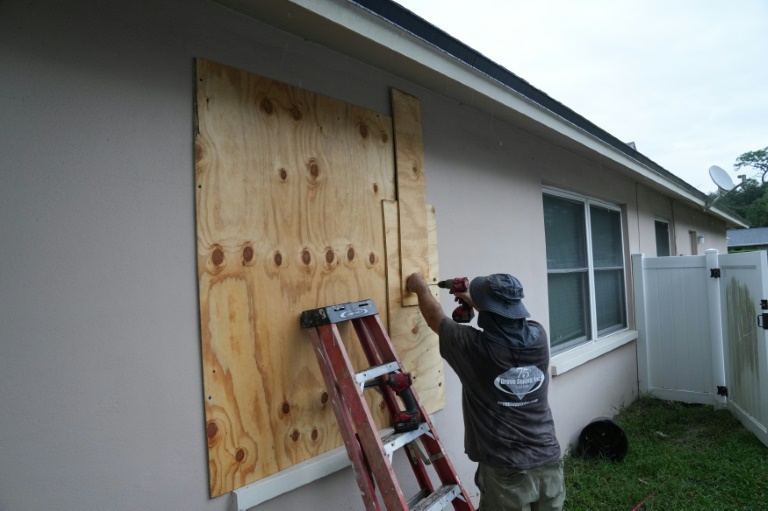Hurricane Milton exploded in strength Monday to become a potentially catastrophic Category 5 storm bound for Florida, threatening the US state with a second ferocious hurricane in as many weeks.
Milton, which is also forecast to graze Mexico’s Yucatan peninsula as it churns eastward, rapidly intensified to the highest category on a scale of five, triggering evacuation orders and warnings of life-threatening conditions on Florida’s west coast.
Communities battered by Hurricane Helene, which slammed Florida as a Category 4 storm late last month, were racing Monday to remove debris that could become dangerous projectiles in Milton’s torment.
“Last time, people’s cars were underwater here in the street… but obviously the bigger issue this time is going to be the wind,” said David Levitsky, a retired homeowner on Treasure Island.
Residents on the low-lying island have been piling up debris from Helene’s flooding in their front yards for eventual removal.
“All this stuff is just wind fodder that’s going to just be blowing down the street and hitting who knows what,” the 69-year-old told AFP.
In its latest advisory, the National Hurricane Center (NHC) said Milton’s maximum sustained winds were 175 miles (280 kilometers) per hour.
While some weakening is forecast as it approaches the US coast, “the system is still likely to be a large and powerful hurricane at landfall in Florida, with life-threatening hazards at the coastline and well inland.”
Local authorities have issued mandatory evacuations orders for some low-lying coastal areas, including in Tampa, a metropolitan area of more than three million people.
“If the storm stays on the current track, it will be the worst storm to impact the Tampa area in over 100 years,” the National Weather Service said on X.
The NHC warned of a major storm surge for Florida’s west coast beginning Tuesday night or early Wednesday, and said Tampa could suffer an influx of water between eight and 12 feet (2.4 to 3.6 meters) above ground level.
Governor Ron DeSantis has declared 51 of Florida’s 67 counties under a state of emergency, warning that Milton will “remain a hurricane at some level all the way through exiting the east coast of Florida.”
In the central city of Orlando, under gray skies, hundreds of cars lined up Monday morning to pick up sandbags.
“We might evacuate, me and my pets, we might go to Georgia,” Tony Carlson, 32, told AFP.
“People think it’s going to be pretty bad,” he said.
Maria Torres, 29, said her family was not planning to evacuate ahead of the storm, but were prepared with a generator, food and water.
The NHC also warned of storm surges raising water levels by five feet (1.5 meters) along Mexico’s Yucatan peninsula and large, destructive waves on the coast.
Rainfall of 10 inches (25 centimeters), with localized spots of up to 15 inches, are expected to cause havoc in Florida, bringing flash flooding.
Emergency workers are still struggling to provide relief in the aftermath of Helene, which killed at least 230 people in several states across the US southeast.
Rescue and recovery efforts after Helene have been hit by a wave of politically-motivated false claims ahead of the November 5 presidential election.
Among the litany of disinformation is the falsehood pushed by Republican candidate Donald Trump that funds have been misappropriated by his rival for the White House, Democrat Kamala Harris, and redirected toward migrants.
Deanne Criswell, head of the Federal Emergency Management Agency (FEMA), dismissed the claims as false.
She also warned Monday that “these storms are bringing more water than they ever have and so while we have the wind risk, the water is what’s killing people.”
Researchers say climate change likely plays a role in the rapid intensification of hurricanes, because there is more energy in warmer oceans for them to feed on.
President Joe Biden was briefed on Milton and said in a statement his administration was readying “life-saving resources.”
Hurricane Helene hit the Florida coastline on September 26 as a Category 4 storm, dumping torrential rainfall, and later causing massive flooding in remote inland towns in states further north, including North Carolina and Tennessee.
The storm was the deadliest natural disaster to hit the US mainland since 2005’s Hurricane Katrina, with the death toll still rising.
DeSantis said power had largely been restored in Florida since last week, but that many electrical teams were deployed in other states badly hit by Helene.
AFP

AFP






